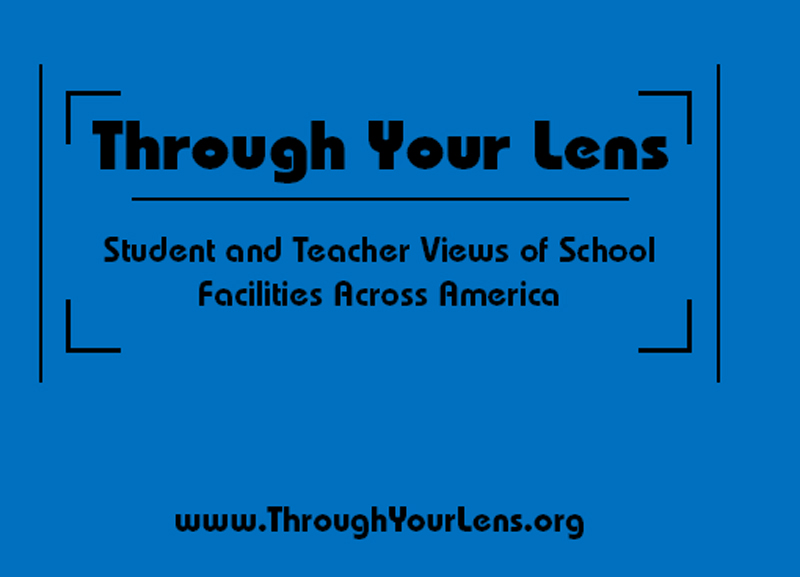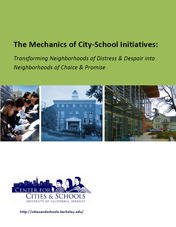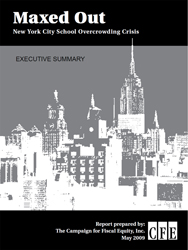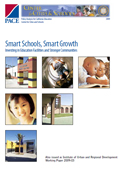Miami seeks deal for residents to use schools’ recreational areas Florida—DECEMBER 29, 2025 Nearly a quarter of Miami residents, and almost half in District Four, do not live within a 10-minute walk of MORE | Arizona’s school facilities crisis, Mohawk Valley School profile Arizona—DECEMBER 27, 2025 Welcome to KAWC’s Educating Yuma, a new program that takes a closer look at the schools, people and MORE | Norwalk's new West Rocks school project will pause for a year to save $5 million Connecticut—DECEMBER 27, 2025 NORWALK — The new West Rocks Middle School will have to wait a little longer to open after city MORE | Watertown Public Schools Awarded State Grant to Support Farm-to-School Program Massachusetts—DECEMBER 27, 2025 The state recently awarded the Watertown Schools a grant to run its farm-to-school program, including its MORE | Hawaiʻi Charter Schools Need Facilities. Could The DOE Be A Solution? Hawaii—DECEMBER 26, 2025
Three years ago, a group of educators went before the state charter school commission with a bold MORE
|
|
|
|
Publications
Interim Analysis of School Facility Funding in the American Recovery and Reinvestment At of 2009 Author(s): 21st Century School Fund Published By: 21st Century School Fund -- 2010: [ abstract] abstract] Published By: 21st Century School Fund Author(s): 21st Century School Fund The 21st Century School Fund, through its Building Educational Success Together (BEST) collaborative, is tracking the effect of federal stimulus funding on the condition of PK-12 public school facilities and whether or not the distribution of ARRA funding related to public school facilities is helping reduce the disparity of capital expenditures among and between school districts. This brief report highlights initial findings related to the following questions: ·How much disparity exists in school facility spending by state and locality? ·How were school facilities addressed in the American Recovery & Reinvestment Act? ·What has happened to our nation’s school facilities as a result of ARRA provisions? ·Which schools and which students benefited from ARRA expenditures?
Download: PDF
Older and Historic Schools: Restoration vs. Replacement and
the Role of a Feasibility Study Author(s): National Trust for Historic Preservation Published By: National Trust for Historic Preservation -- 2010: [ abstract] abstract] Published By: National Trust for Historic Preservation Author(s): National Trust for Historic Preservation Weighing the pros and cons of renovating an older school or building a new one takes preservation “know-how,” experience and creativity. Prevailing assumptions—that a newer school will result in a better education or misperceptions that older school buildings have unfixable flaws—place these schools at risk. The potential for renovation is sometimes dismissed without full consideration of the facts and long-term implications. Download: PDF
Through Your Lens: Student and Teacher Views of School Facilities Across America Author(s): BEST Collaboration Published By: 21st Century School Fund, Critical Exposure, Healthy Schools Campaign -- 2010: [ abstract] abstract]  | Published By: 21st Century School Fund, Critical Exposure, Healthy Schools Campaign Author(s): BEST Collaboration The Through Your Lens book brings together the vivid photos and poignant stories of students and teachers across America with context from statistics, maps and background. It illustrates current school conditions, how our system reached this point, and what is possible for all students and teachers. Perhaps most important, it answers the question, "How can we change this?" This book was developed from the joint efforts of the 21st Century School Fund, Critical Exposure and Healthy Schools Campaign.
Download: PDF |
Analysis of the Utilization of PS-15 School Building in Brooklyn, New York Author(s): 21st Century School Fund -- 2010: [ abstract] abstract] Author(s): 21st Century School Fund The 21st Century School Fund conducted an analysis of the utilization of PS-15 elementary school building in the Red Hook neighborhood in Brooklyn, NY at the request of Campaign for Fiscal Equity. Visiting the school and reviewing plans and documents, 21CSF recommended that the Department of Education (DOE) reconsider its decision to increase the charter school partner, PAVE over the course of two years.
Download: PDF
FIRST DRAFT -- Planning Specifications: Educational and Community Program Description and Space Needs, Bruce Monroe Elementary School (Appendix)-- 2010: [ abstract] abstract] This is the Summary of Spaces Appendix, which is appended to the report "Planning Specifications: Educational and Community Program Description and Space Needs, Bruce Monroe Elementary School" (November 2009), which was submitted for review to the school and community of Bruce-Monroe at Park View Elementary School and the District of Columbia Public Schools. This appendix lists each specific program area with a square-foot allotment and provides an estimated working total of the area required. Download: PDF
Is Federal Stimulus Funding on PK-12 Public School Facilities Reducing Disparity between School Districts? Author(s): 21st Century School Fund -- 2010: [ abstract] abstract] Author(s): 21st Century School Fund The 21st Century School Fund, through its Building Educational Success Together (BEST) collaborative, is tracking the effect of federal stimulus funding on the condition of PK-12 public school facilities and whether or not the distribution of ARRA funding related to public school facilities is helping reduce the disparity of capital expenditures among and between school districts. This brief report highlights initial findings related to the following questions: How much disparity exists in school facility spending by state and locality? How were school facilities addressed in the American Recovery & Reinvestment Act? What has happened to our nation's school facilities as a result of ARRA provisions? Which schools and which students benefited from ARRA expenditures?
Download: PDF
San Francisco's Public School Facilities as Public Assets: A Shared Understanding and Policy Recommendations for the Community Use of Schools Author(s): Center for Cities and Schools Published By: Center for Cities and Schools -- 2010: [ abstract] abstract]  | Published By: Center for Cities and Schools Author(s): Center for Cities and Schools Report prepared for San Francisco Unified School District and San Francisco's Department of Children, Youth, and Their Families This report presents research findings and policy recommendations from a year-long process involving a diverse stakeholder group to establish a more effective "joint use" strategy in San Francisco that supports students, families, schools and communities. The report includes: a) detailed descriptions and diagrams of current SFUSD facility policies and processes; b) findings on current utilization, management, policy, and budget: and c) policy recommendations to encourage a "culture" of community use of schools that prioritize partnerships with organizations that provide programs and services to SFUSD students and that are aligned with the District's goals.
Download: PDF |
The Value of School Facility Investments: Evidence from a Dynamic Regression Discontinuity Design Author(s): Stephanie Riegg Cellini, Fernando Ferreira and Jesse Rothstein Published By: The Quarterly Journal of Economics -- 2010: [ abstract] abstract] Published By: The Quarterly Journal of Economics Author(s): Stephanie Riegg Cellini, Fernando Ferreira and Jesse Rothstein "Despite extensive public infrastructure spending, surprisingly little is known about its economic return. In this paper, we estimate the value of school facility investments using housing markets: standard models of local public goods imply that school districts should spend up to the point where marginal increases would have zero effect on local housing prices. "
Link: HTML
Mechanics of City-School Initiatives: Transforming Neighborhoods of Distress & Despair into Neighborhoods of Choice & Promise Author(s): Center for Cities and Schools Published By: Center for Cities and Schools -- 2009: [ abstract] abstract]  | Published By: Center for Cities and Schools Author(s): Center for Cities and Schools This policy brief introduces HUD and others to our evidence based framework for action: the 10 PLUS Mechanics of Change. Grounded in lessons learned from both nationally recognized policies and practices and the hardwon results of Bay Area initiatives, our 10 PLUS Mechanics of Change explain the nuts and bolts of cityschool district initiatives for community and school transformation. We illustrate the tools and strategies in our framework by describing the experience of three PLUS collaborations. The brief ends with a set of recommendations for how HUD and other agencies can support local and regional efforts to transform neighborhoods of distress and despair into neighborhoods of choice and promise.
Download: PDF |
Repair for Success: An Analysis of the Need and Possibilities for a Federal Investment in PK-12 School Maintenance and Repair Published By: 21st Century School Fund -- 2009: [ abstract] abstract] Published By: 21st Century School Fund This report describes how a new national commitment to address the deferred maintenance and renewal of our nation’s PK-12 public school buildings will improve our education system, the economy and the environment. A $27 billion federal investment, just 10% of the minimum estimated total need, would take us a major step closer to ensuring that the nearly 55 million staff and students who attend school daily are in healthy, safe and educationally appropriate environments. This investment will also quickly create between 160,000 and 235,000 jobs that will protect our environment and sustain the public infrastructure investments made by earlier generations.
This analysis was utilized by the Economic Policy Institute in their “American Jobs Plan” study to address the U.S. jobs crisis.
Download: PDF
Research on the Impact of School Facilities on Students and Teachers: A Summary of Studies Published Since 2000 Author(s): 21st Century School Fund Published By: 21st Century School Fund -- 2009: [ abstract] abstract]  | Published By: 21st Century School Fund Author(s): 21st Century School Fund There has been a slow but steady increase of research on the impact of public school facilities on educational achievement and community outcomes and of the rigor of the research. This summary of studies is part of a larger literature review conducted by the 21st Century School Fund with funding from the Charitable Trust of the Council on Educational Facility Planners International. The review is designed as an update to the 2002 review “Do School Facilities Affect Academic Outcomes?” by Mark Schneider, originally commissioned by the 21st Century School Fund’s Building Educational Success Together collaborative and then expanded by Dr. Schneider and published by the National Clearinghouse for Educational Facilities. Recent research continues to point to a small but steadily positive relationship between the quality of a public school facility and a range of academic and community outcomes. This study reviews the literature on: • Facilities & academic outcomes • School building systems • School facility condition and community factors This new review, available in September 2010 includes an extensive bibliography of research since 2002 and discusses the need for future school facility research.
Download: PDF |
Maxed Out: New York City School Overcrowding Crisis Author(s): Campaign for Fiscal Equity Published By: Campaign for Fiscal Equity -- 2009: [ abstract] abstract]  | Published By: Campaign for Fiscal Equity Author(s): Campaign for Fiscal Equity This report finds that 48% of New York City’s public school students attended an overcrowded school or a school that utilizes a temporary structure such as a trailer or annex during the 2006-07 school year. CFE examined data from every school in New York City to provide a comprehensive overview of the most urgently overcrowded schools and school districts and proposes a policy framework for the Department of Education (DOE) to tackle the crisis.
Download: PDF
Link: HTML |
Smart Schools, Smart Growth: Investing in Education Facilities and Stronger Communities Author(s): Center for Cities and Schools Published By: Center for Cities and Schools, PACE -- 2009: [ abstract] abstract]  | Published By: Center for Cities and Schools, PACE Author(s): Center for Cities and Schools Joint working paper by PACE and Center for Cities and Schools that explores California's historic $82 billion school construction investment opportunity to advance educational quality and lift local communities. This report contributes to a new conversation about how mindful school construction decisions can enrich metropolitan areas and sustainable forms of regional development.
Download: PDF |
An Application of “Broken‐Windows” and Related Theories to the Study of Disorder, Fear, and Collective Efficacy in Schools Author(s): Stephen B. Plank, Catherine P. Bradshaw, and Hollie Young Published By: American Journal of Education -- 2009: [ abstract] abstract] Published By: American Journal of Education Author(s): Stephen B. Plank, Catherine P. Bradshaw, and Hollie Young "This article considers school climate and perceptions of social disorder. When a school is characterized by disorder or physical risk, basic educational goals and processes are jeopardized. We use survey data from 33 public schools serving grades 6–8 in a large mid‐Atlantic city to examine relationships among physical disorder (e.g., broken windows and poor building conditions), fear, collective efficacy, and social disorder."
Link: HTML
Analysis of the Impact of DCPS School Closings for SY2008-2009 Memo Author(s): 21st Century School Fund, Urban Institute, Brookings Institution -- 2009: [ abstract] abstract] Author(s): 21st Century School Fund, Urban Institute, Brookings Institution This memo examines the enrollment patterns resulting from the DCPS 2008-2009 school closings. Although it focuses on the impact of the closings on student enrollment, it also lays out key questions for the school system to consider as it evaluates the impact of the closings on educational program quality and on budget pressures.
Download: PDF
Effects of school design on student outcomes. Journal of Educational Administration. Author(s): Tanner C. Kenneth Published By: Journal of Educational Administration -- 2009: [ abstract] abstract] Published By: Journal of Educational Administration Author(s): Tanner C. Kenneth "The purpose of this study is to compare student achievement with three school design classifications: movement and circulation, day lighting, and views."
Link: HTML
FIRST DRAFT -- Planning Specifications: Educational and Community Program Description and Space Needs, Bruce Monroe Elementary School Author(s): 21st Century School Fund -- 2009: [ abstract] abstract] Author(s): 21st Century School Fund This is a first draft for review by the school and community of Bruce-Monroe at Park View Elementary School and the District of Columbia Public Schools. It describes the extensive and complex programs, services and operations of the school and is primarily intended to be used by a developer and architect to formulate a site plan -- and eventually a new school design - - for sharing the former school site with residential, commercial or retail development along Georgia Avenue. The Summary of Spaces Appendix is also a first draft. It lists each specific program area with a square-foot allotment and provides an estimated working total of the area required.
Download: PDF
Spending on school infrastructure: Does money matter? Author(s): Faith E. Crampton Published By: Journal of Educational Administration -- 2009: [ abstract] abstract] Published By: Journal of Educational Administration Author(s): Faith E. Crampton The researcher conducts a study on the impact of school infrastructure investments on student achievement.
Link: HTML
Teacher Attitudes about Classroom Conditions Author(s): Glen Earthman, Linda Lemasters Published By: Journal of Educational Administration -- 2009: [ abstract] abstract] Published By: Journal of Educational Administration Author(s): Glen Earthman, Linda Lemasters "This research was designed to investigate the possible relationship between the attitudes, teachers have about the condition of their classrooms when the classrooms were independently assessed."
Link: HTML
The relationship between the condition of school facilities and certain educational outcomes, particularly in rural public high schools in Texas. Author(s): Martin Eugene Sheets Published By: Texas Tech University -- 2009: [ abstract] abstract] Published By: Texas Tech University Author(s): Martin Eugene Sheets "The purpose of this study was to examine the relationship between the condition of rural public high school facilities in Texas and student achievement, student attendance, and teacher turnover, while controlling for the effects of student wealth level, school district wealth level, and percent minority students."
Download: PDF
Link: HTML
|
|
|
